FEDERATION
In developed countries, a passion for physical culture and sports is an important part of people’s lives at any age. One of the most popular areas in sports abroad is a relatively new, but very popular all over the world variety of all-around – triathlon. In many countries, the fascination with continuous triathlon has become truly popular, which led to the creation of the European and International Federations, the World Triathlon Corporation, as well as the inclusion of a new sport in the program of the Summer Olympics. Competitions to overcome three different distances (depending on the type of program) are gaining popularity in our country. However, issues related to the emergence and development of continuous triathlon are far from fully understood.

In the modern sports world, triathlon is one of the most popular cyclic sports in North America, Europe and Southeast Asia. There it is as popular as marathon running, cycling and cross-country skiing.
Triathlon (English triathlon, derived from the Greek words: tri – three, and athlon – competition, wrestling) includes three different sports competitions (depending on the type of program), one after the other in a continuous sequence. There is a legend of the emergence of continuous triathlon, which says that in 1978, three students of the American Sports Academy – swimmer, cyclist and runner – argued about which of them is more endurable, and organized competitions among themselves. In fact, triathlon has a deeper and more interesting history!
According to the world champion in classical distance Scott Tinley (historian of triathlon), this sport originates from the competition, popularly called “Race of the Persistent”, held in France in 1920-1930. In the city of Rochelle in 1920 for the first time held the start of “Les Rrois Sport” (three sports competitions) is something like a modern triathlon, which included 3 km of running, 12 km of cycling and overcoming the 200-meter Marne canal, and all this without a break between stages. This is mentioned in the newspaper “L’Auto”.

On September 4, 1921, a similar competition called “Course Les Trois Sport” was held in Marseilles, which included 7 km of cycling, 5 km of running segment and 200 m of swimming. Again, “Les Trois Sport” in Rochelle are held only after 14 years: in 1934, and also consist of three sports (length and sequence of stages changed): crossing the canal (200 m), 10 km of cycling race around the city harbor and park, as well as a 1200 m run through the stadium. And since the mid-30s, and until 1974, such competitions were not held in the world.
In the early 1970’s, a healthy lifestyle, promoted by the famous New Zealand coach Arthur Liddard as a means of combating aging and cardiovascular disease, became increasingly popular among supporters of a healthy lifestyle, especially in New Zealand and the United States. Lidyard has put a lot of effort into promoting mass sports, and today people who do not engage in any type of physical activity at any age are considered ill-mannered in the West.
In 1971, 35-year-old Jack Johnstone, a former member of the All-American Student Swimming Team, decided to regain his former youthful slimness, and began to take an active part in amateur races. Jack competed in the original Biathlon Payne (a combination of 7.24 km and 250 m), which was held among California rescuers in San Diego (USA), where he became 12th among more than 100 participants. At the finish line, he had the idea to organize his own “biathlon” in a similar format, but increase the swimming distance to find out: how many runners can swim as well as he can run?

With this idea, he turned to the local sports club “San Diego Tracking Club” to find a place for his continuous duel in the calendar of their competitions. However, there he was advised to first contact Don Shanahan, “another madman with a similar idea.” Shanahan suggested that Johnstone include a bicycle stage in his proposed competitions. He readily agreed, and like-minded people enriched the San Diego calendar with an unusual start, and English with the new word “Triathlon” (the word “triathlon” appeared in Webster’s English dictionary in 1983).
The Mission Bay Triathlon took place on September 25, 1974 at 5:45 PM in the Mission Bay suburb of San Diego, California. 46 athletes took part in the race, who consistently and without a break covered 8045 km by bicycle, 9654 km by running and 804.5 m by swimming. Everyone who started successfully completed the distance. The first five received awards, and rescued Bill Phillips won with a score of 0:55:44.

The date of the above competitions is celebrated today in the world as the birthday of modern short distance triathlon.
A similar competition called “Optimist Sports Fiesta Triathlon” was also held in Colorado (USA) in 1976.
Jack Johnstone and Don Shanahan, with the support of the San Diego Sports Club, held the Mission Bay Triathlon annually until the early 1980s, when the world learned about the new sport. Although triathlon owes this to other people…

Another obsession was born in 1977, during the award ceremony of the Oahu Rehay Perymetr (a team of 5 people consistently covered a distance of 214 km around the island of Oahu, Hawaii, USA). Among the participants, which included numerous representatives of the Mid Pacific Road Runners and swimming clubs (Waikiki Swim Club), there was a lively controversy about which athletes are more endurance – runners or swimmers? As a result, one of the athletes, 42-year-old John Collins (a senior U.S. Marine officer), intervened in the discussion. He said that, according to a recent article in the most popular American magazine “Sport Illustrated”, the legendary Belgian cyclist Eddie Merck has the highest recorded rate of maximum oxygen uptake, and suggested that cyclists are perhaps the most enduring compared to runners and swimmers. This information further fueled passions…
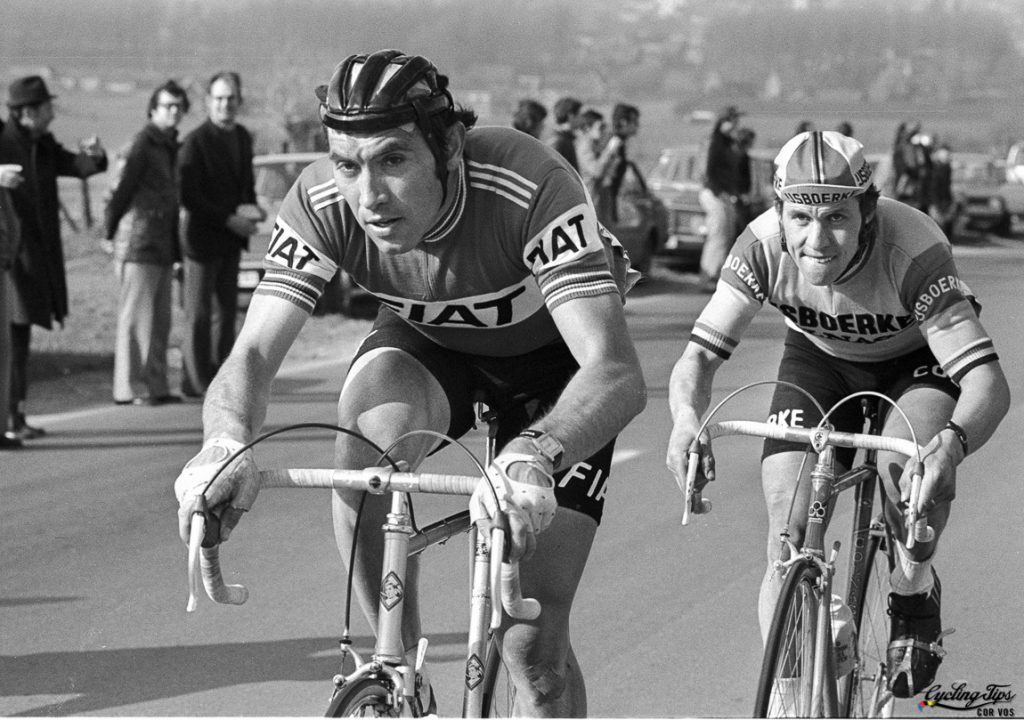
Some of those present recognized such a proposal as a joke, considering it impossible for a person, even a well-trained person, to swim a distance of 3862 km without rest, ride a bicycle 185035 km, and then run a marathon of 42195 km. Such a race for endurance is an incredible test for a person. However, Collins was not joking at all – this idea inspired him!
John Collins himself was not a newcomer to such competitions in continuous triathlon, he had previously participated in short distance triathlon – “Mission Bay Triathlon” and “Optimist Fiesta Sport Triathlon”. At the banquet, which took place after the award ceremony, he publicly announced that he would personally organize this start next year, and would invite everyone to take part in it. “It doesn’t matter who comes first. We will call anyone who can cover the distance an Iron Man! ”Said Collins. He proposed to name the finisher in a similar way in honor of one of the Hawaiian runners, who was widely known for his grueling training.

In preparation for the above competition, the length of the Around Oahu cycling route had to be reduced by 4,835 km (to 180.2 km) to accommodate the cycling stage between the finish of the Waikiki Stormy Waters and the start of the Honolulu Marathon. Thus, as a result of the controversy over the endurance of various sports, a classic triathlon appeared, and the first competitions called “Iron Man” in the long distance – 3862 km swimming + 180.2 km cycling race + 42195 km running. The competition was held on February 18, 1978 in Honolulu (Hawaii, USA). Before the tournament, each athlete received instructions with several rules and a description of the route. Of the fifteen athletes who took part in the start, twelve, including John Collins himself, reached the finish line. With the result of 11:46:58 Gordon Haller (a taxi driver from Honolulu) won. All finishers received a small figure of a man made of iron pipes. It is interesting that the honorary title “Iron Man” won in triathlon, as well as the title of Olympic champion, is awarded for life and does not accept the prefix “ex”!
In 1979, 14 men and one woman went to Hawaii to conquer the second stage of the Iron Man. Tom Warren (owner of a bar in San Diego) was the first to cover the distance, and Lynn Lemaire from Boston, the holder of the US national record in the hour bike race, finished fifth in the overall standings, becoming the first “Iron Woman” in the history of classic triathlon.
Perhaps this would be the end of the Iron Man tournament, as Collins was already planning to turn his overmarathon into a relay race to attract more participants… As many unusual competitions appear and disappear, so did the start in September 1921 in Marseille with Course Les Trois Sport was held only once, and was not continued. And the triathlon in San Diego was an annual, but only a little-known competition. It is likely that the brainchild of John Collins “Iron Man” – the same fate awaited. But life was different: among the spectators of the second classic triathlon in Honolulu was journalist Barry McDermott. Impressed by what he saw, he wrote and published a report on the competition in the pages of “Sport Illustrated” magazine, where he informed the general public about this amazing sport. The small literary masterpiece aroused increased interest in unusual competitions among Americans. This article was followed by other publications, and the triathlon began its triumphant march across the planet!

McDermott’s article about the second Iron Man competition in Hawaii was the impetus for the promotion of a new direction in sports. 106 men and 2 women took part in the start of the third classic triathlon on the island of Oahu in February 1980. ABC TV broadcast the competition live, and all of sports in America cheered for the hundreds of daredevils fighting on the track. Swimming coach Dave Scott of Davis won with a result of 9:24:33 (the best result in the world in overcoming a long distance belongs to the Belgian Luke Van Lirde – 7:50:27).
In 1982, triathlon became a professional sport in the United States. Due to the spectacle and attractiveness, in the 80’s of the last century began its rapid development around the world. In different countries, groups of enthusiasts are formed, which organize and conduct competitions in continuous triathlon at different distances. This is usually a local club competition for short distances. Their spontaneous activities are gradually organized, uniform rules are developed, distances are standardized and a single competition calendar is drawn up, which eventually led to the creation in 1984 of the European Triathlon Federation (ETU).

Prior to that, the first competitions in Europe were held in Czechoslovakia (Plzen, 1980), the Netherlands (Palmyra, 1981), Germany (Leipzig, 1981), France (Nice, 1982), and in 1985 was held first European championship.
In May 1989, the International Triathlon Federation (ITU) was formed in Avignon, France, which took over all the work of holding the annual World Championships, World Cups and other sporting events (in 1990, about 80 countries became members). There is also a combined triathlon distance – 51.5 km (1500 m swimming + 40.0 km cycling + 10.0 km running), proposed by the organizers of the great American triathlon series (USTS) Jim Carl and Carl Thomas is accepted as a standard for international starts. Three months later, Avignon hosted an international competition at an approved distance.
The first official world championship under the auspices of the ITU took place in 1990 in Orlando (USA). Since then, the ETU has held annual European Championships, European Cup draws and many other international triathlon competitions.
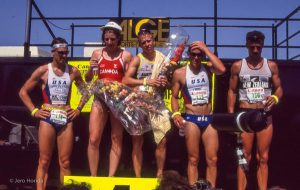
The ITU, whose main goal was to include a new cyclical sport in the Olympic program, led by its president, Lassie MacDonald, made sure that in 1994, at the regular session of the International Olympic Committee (IOC) in Paris, the inclusion of triathlon was announced (along with taekwondo and trampoline jumping) in the program of the XXVII Summer Olympic Games. This was a well-deserved recognition of the high popularity of this sport in the world. The first set of awards in continuous triathlon in the international (short) distance 1.5 + 40 + 10 km was drawn in 2000 at the Olympics in Sydney.
As for the classic distance competition, in 1981 the US Navy Command transferred John Collins from the Hawaiian capital Honolulu to Washington, and he left his “child” under the care of Valeria Silk, co-owner of a local fitness club.
The popularity of “Iron Man” also increased. Every year the number of starters increased, even despite the introduction of a very significant entry fee by the organizers. The start of “Iron Man” became a successful commercial enterprise (the prize fund in 1986 was one hundred thousand US dollars), and became a well-known brand. Since 1990, the rights to it belong to another private company – the World Triathlon Corporation (WTC). Today, the WTC is a series of 43 stages of competition around the world, collecting start-up fees of more than $ 25 million.
Up to 1,500 athletes take part in typical competitions of this series. The largest of them in Europe – Challenge Roth – gathers more than 2300 participants (these competitions usually have a limit on the number of participants, which is selected long before the start). As a result, the selection for the main start of the WTC called “Ironman Kona Triathlon” (Hawaii), which is the world championship in the relevant distance.
However, triathlon is attractive not only by the mass of simultaneously starting athletes (the Chicago stage is considered to be the most numerous in the world – more than 8,000 participants), but also by the total number of competitions. The US Triathlon Federation (USAT) calendar alone has over 1,800 officially registered starts!
A new kind of all-around in the early 80’s attracted attention in the Soviet Union. However, in the USSR, the Committee on Physical Culture and Sports under the Council of Ministers paid attention mainly to those sports that were included in the program of the Olympic Games. New directions have been studied for a long time and carefully. But triathlon was lucky (unlike bodybuilding and karate). The amazing newcomer began to be closely watched in the Union Republics – Russia, Latvia, Estonia, Ukraine, Moldova.

The development of continuous triathlon in the USSR dates back to the original competitions held in the summer of 1983 by the Manzhosov Club in the Moscow region according to the following formula: 60 km cycling + 400 m swimming + 12.0 km cross-country running. The first long-distance triathlon competitions (3862 km of swimming + 180.2 km of cycling + 42195 km of running) were held in 1984 in two Baltic republics – the Lithuanian SSR (Baltoi-Voke) and the Estonian SSR (Tartu). Similar competitions were held in 1985 in the RSFSR (Perm), and in 1987-1988 – in the Ukrainian SSR, Odessa, they were organized and conducted by F. Aliyev, Z. Sosnovsky and L. Rzhepishevsky – representatives of the Moscow Art Theater. “SPECTRUM”).
The growing interest in the new sport was the basis for holding in the capital of the Moldovan SSR on July 9, 1988 on the initiative of the Voluntary Physical Culture and Sports Association of Trade Unions (under the leadership of the Chairman of the Chisinau City Council DFSO Trade Unions AN Fedoseeva) for the prize of the newspaper “Youth of Moldova”. Competitions were held in the format of 1 km of swimming + 45 km of cycling + 10.5 km of running.
Volodymyr Vodlozerov, a professional road cyclist, was the first of the sixteen participants, Valery Kiselyov (both students of the Faculty of Physical Education of the MV Frunze Simferopol State University) was the second with an eight-minute lag () and Oleksandr Plamadyalov was the third prize-winner. the winner in 12 minutes (the fourth was a member of the national team of Moldova in all-around TRP Valery Tolokotnikov). In total, from the announcements published in the newspaper “Soviet Sport” in 1988, in the Soviet Union were held more than 20 starts in triathlon at different distances.
In May 1989, in the Ukrainian SSR, under the leadership of the head of the Department of Modern Pentathlon, Fencing and Shooting, Dryukov VA, the championship of the Kyiv State Institute of Physical Culture and Sports in triathlon was held at a distance of 1.5 / 40/10 in a unique format 1+ 2. The competition was held in two stages: swimming in the pool, and led with a running segment – handicap, according to the results in swimming. Swimmer Stanislav Dryukov was first, pentathlete Eduard Panarin was second and cyclist Igor Ishchuk was third.
Competitions held in Chisinau, Kyiv, Minsk, Moscow, Nizhny Novgorod and other cities of the Soviet Union aroused increased interest in the sports community to start in short distances, and in June 1989 the capital of Moldova met 17 teams participating in the first All-Union triathlon relay. Each team consisted of four athletes, who one after another in a continuous sequence overcame first swimming (750 m x 4), then cycling (20.0 km x 4), and finally running (5.0 km x 4) segments of the distance.
The winners and prize-winners of the relay were the teams of Moscow, Leningrad and Simferopol. In addition, the jury “for the will to win, optimism and high sportsmanship” awarded a special prize to Ukrainian athlete V. Vodlozerov, who demonstrated the best sports result in the overall standings at these competitions.
The new sport was actively gaining many fans, and on July 23, 1989, the All-Union Triathlon Tournament for the prize of the newspaper “Evening Odessa” took place in Odessa in two formats – short (1.5 + 40 + 10 km) and long. At the start (3862 + 180.2 + 42195 km). In the Odessa triathlon in 1987, 18 athletes took part, and in 1988 – 37. But in 1989, more than a hundred athletes came to the start, representing club teams from all over the Soviet Union, and were ready to pass the competition exam. At the Olympic distance in a serious men’s “showdown” the winner was determined shortly before the finish. A. Lomakin (Makeyevka) became the triumphant at the classical distance.
As two other Simferopol athletes became prize-winners of these competitions (V. Nagorny was the third on “Olympic”, and V. Kiselyov – the second on “classics”), they, led by the captain, became leaders and in a team event. After this tournament, having taken the entire podium of honor, the Crimeans completely switched to performances in international starts.
The popularity of continuous triathlon has grown even more, its mass and spectacle served as prerequisites for the emergence of full-fledged triathletes. In addition to the Faculty of Physical Education of Simferopol State University. MV Frunze (1987), this specialization also appeared at the Kyiv State Institute of Physical Culture and Sports (1988). At the same time, the specialization “triathlon” was introduced on the basis of the general military school of Omsk and the State Academy of Physical Culture. PF Lesgaft (Moscow). Also, in 1989, the department of modern pentathlon (horse racing, fencing, pistol shooting, swimming, running) of the Leningrad Sports Association “Dynamo” was reoriented to triathlon (one of the reasons for the reorientation was the lack of its own horse base).
Repeatedly (since 1987) triathlon team

The purpose of the All-Ukrainian public organization of physical culture and sports was to promote the development of triathlon in Ukraine, increase the role of physical culture and sports for the comprehensive development and health of citizens (re-registration of FTU in independent Ukraine was held in 2005, after the inaugural conference 04.11.2004). Since then, the new cyclic sport, along with Odessa, Lviv, Simferopol, Kyiv, has been actively gaining fans in Zhovti Vody, Kharkiv, Makiyevka, Dnipro, Sevastopol and other cities.
In addition to participating in all-Union competitions held in Daugavpils, Tartu, Zalenogorsk, Alma-Ata (Ukrainians took the third place in Kazakhstan), the formed Ukrainian triathlon team at the end of September 1990 took part in the III International tournament “Bolga Lyulin’90” . The winner, as in the previous year, was the Czech Thomas Kochar.
The impetus for the further development of a new sport in the USSR was the adoption by the Presidium of the CA “Dynamo” of the resolution of February 21, 1991 “On the development of triathlon in the company” Dynamo “.
On March 17, 1991, FTU held a short distance triathlon competition in Sevastopol. D. Gulyaev (winners A. Makushin and A. Dorodnov) won. On August 17, 1991, Ukrainian athletes took part in a triathlon in Krylatsky (Moscow). The winner was A. Nikulshin from Moscow.
After the collapse of the USSR (August 21, 1991), triathletes were largely unclaimed, and many athletes switched to international competitions. The first continuous triathlon championship in independent Ukraine was held in 1992 in Ternopil, where the medal of the highest test was won by Bogdan Mykhalus from Lviv (later he competed in the famous Hawaiian triathlon “IRONMAN” – 1995, 1996, 1997 among the professional athletes).
With the granting of Olympic status to the IOC in 1994, our sport in Ukraine has received a new round of development. Prior to that, the emphasis was on retraining athletes in other sports (the ideal candidate for triathletes was a 14-year-old swimmer at the competitive level, who has the ability to run). At first, this may have been justified. But the days when athletes who have their own striking appearance (swimming, cycling or running) succeeded in triathlon are over. There was an urgent need for targeted specialized training of triathletes in sports schools.
Over time, the relevant departments were opened in sport schools, which train young triathletes. The centers of development of the new sport are: Dnipro, Donetsk, Zhytomyr (the first place in the competition in Ukraine is Zhytomyr region), Zaporizha, Kyiv, Lviv, Kharkiv, Cherkasy, and their geography is constantly expanding.

In the summer of 2007 in the city of Pereyaslav-Khmelnytsky the first in Ukraine independent International triathlon tournament on long distance called “Slavic wave” in the format of 3,0 + 80,0 + 20,0 km in which athletes from Belarus took part took place, Ukraine, Russia, USA. The following year, these competitions were held in parallel with the open championship of Ukraine in the “semi-iron” distance (1.9 + 90.0 + 21.1 km). Since 2009, “Slavic Wave” is held in the rank of the championship of Ukraine. Since 2007 in the city of Novoyavorivsk of the Lviv region the open championship of Ukraine in “Olympic” and in relay relays (in a team of two men and two women) is annually held. In July 2009, an open championship and the Cup of Ukraine in the short distance (1.5 + 40.0 + 10.0 km) took place near Odessa (Yuzhny).

In parallel with the development of traditional triathlon, under the aegis of FTU, its varieties – aquathlon, duathlon and winter triathlon – are gaining recognition in Ukraine. Relays, which are held at different distances with different composition of teams, are gaining more and more popularity. In the off-season, when weather conditions prevent swimming in open water, cycling and running on the highway, athletes compete in aquathlon (swim in the pool and run in the arena).
In January 2010, the Aquathlon Championship of Ukraine was held in Kharkiv in the format of dual events (swimming and running), in which more than 150 athletes from 12 regions, aged from 10 to 23 years, took part. In total, in accordance with the Unified calendar plan of physical culture and sports events in Ukraine, during 2010 FTU held 16 all-Ukrainian competitions in various types of triathlon programs. In addition, national duathlon championships (running+cycling+running) are held in different age groups. In 2007, such competitions were held in Kyiv, in 2008 – in Kreminna, Luhansk region. Representatives of 10 regions of Ukraine took part in the competition. Amateurs and veterans competed at the “Odesa Duathlon” distance (5.0+20.0+2.5 km) in November 2009 (Odesa).
The fact that the IOC is soon going to include winter triathlon in the program of the White Olympics has activated the development of this type of triathlon in our country. Since 2007, competitions of this type of program in the format of 7.0 km running + 12.0 km cross-country bicycle race + 10.0 km cross-country race for men have been held annually in Kyiv in January. The championship competition among juniors, women, amateurs and veterans takes place at a distance of 3.0+5.0+5.0 km, respectively
.
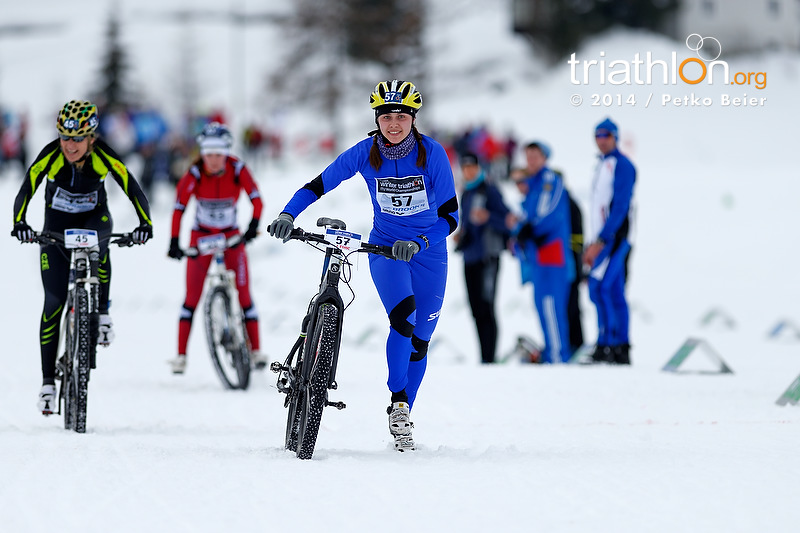
In parallel with the development of traditional triathlon, under the auspices of the FTU are gaining recognition in Ukraine and its varieties – aquathlon, duathlon and winter triathlon. Relay relays, which are held at different distances with different teams, are becoming more and more popular. In the off-season, when the weather conditions do not allow you to swim in open water, ride a bike and run on the highway, athletes compete in aquathlon (running in the arena, swimming in the pool and running again).
In January 2010, Kharkiv hosted the Ukrainian Aquathlon Championship in the format of dueling (swimming and running), which was attended by more than 150 athletes from 12 regions, aged 10 to 23 years. In total, according to the Unified calendar plan of physical culture and sports events in Ukraine, during 2010 FTU held 16 all-Ukrainian competitions in various types of triathlon program. In addition, national championships in duathlon (running + cycling + running) are held in different age groups. In 2007 such competitions took place in Kyiv, in 2008 – in Kreminna, Luhansk region. Representatives of 10 regions of Ukraine took part in the competition. Amateurs and veterans competed in the distance of the “Odessa Duathlon” (5.0 + 20.0 + 2.5 km) in November 2009 (Odessa).
The fact that the IOC is soon going to include winter triathlon in the program of the White Olympics, has intensified the development of this type of triathlon in our country. Since January 2007, competitions in this type of program have been held annually in Kyiv in the format of 7.0 km of running + 12.0 km of cross-country cycling + 10.0 km of men’s skiing. The championship competition among juniors, women, amateurs and veterans is held at a distance of 3.0 + 5.0 + 5.0 km, respectively.

In 2006, at the European Championships in Croatia (Rijeka), Ukrainian athletes won the relay, and in 2007 in Hungary (Tisayvaros) they were second at the World Championships, with Yulia Elistratova, Olesya Prystaiko and Inna Tsyganok as part of the team. Following the results of the world championship and three best results shown at the stages of the World Cup in 2009, the Ukrainian triathlete Yulia Elistratova topped the world rating of ITU (1749 points) among athletes under 23 (the second on the list is Daniel Reef from Switzerland – 950 points , the third German Rebecca Robish – 905 points).
In 2007, Elistratova Julia finished fourth at the European Championships in Copenhagen (Denmark) and at the World Championships in Hamburg (Germany), and won gold at the ninth stage of the European Cup in Antalya (Turkey). Victor Zemtsev became the long-distance world champion in 2006, and in 2009 he won the stage of the world championship series (about 3,000 people took part in the competition) in the “classics” in Kentucky (USA), spending 8:25 to overcome it: 27 hours. The winners of two Asian Triathlon Cups in China in 2009 were Danilo Sapunov and Yulia Yelistratova in Beijing (July 25) and Maxim Chorny in Yuaguang (August 8). At the next stage of the European Triathlon Mixed Relay Championship, which took place in July 2009 in Holten (Holland), our national team of Olesya Dereza, Olesya Prystaiko, Rostislav Pevtsov and Oleksiy Syutkin became the winner. In August 2010, our women’s and men’s national teams became the best at the European Triathlon Championships among police officers in Austria. At these competitions, police lieutenant Yulia Yelistratova also won in the individual competition. Vasily Makedon and Serhiy Kurochkin have repeatedly won and were among the prize-winners of the World Cup stages, and Andriy Yastrebov became the world champion in one of the types of triathlon program – duathlon.
In 2010, our compatriot Yulia Yelistratova became the first Ukrainian to win a gold medal at the World Cup! And one year earlier, the woman from Zhytomyr became the European champion among young people, and then twice in a row won prizes at the continental championship in her age group. Many new names have appeared in Ukrainian triathlon, including Yegor Martynenko, Rostislav Pevtsov, Ivan Ivanov, Inna Ryzhykh, Oleksandra Stepanenko and others. These triathletes have won many awards, both domestically and internationally.
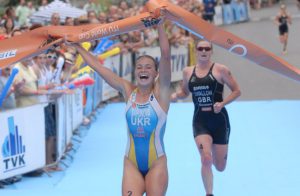
In 2011 in the Spanish city of Pontevedra, the Ukrainian triathlon team in mixed relays won a silver medal in the continental championship! And a year later, the four of us were again on the podium, this time with a third result. In 2011, the national team of Ukraine was represented for the first time at the European Paratriathlon Championship! In the city of Eilat (Israel), our compatriot Volodymyr Stepanenko, at the age of 18, showed a worthy result from the first attempt, finishing within the top ten! In 2009, Yuriy Zablotsky from Lviv obtained a license for Ukraine for the First Youth Olympic Games, which took place in Singapore a year later. Unfortunately, Yuriy was not able to perform at these competitions due to injuries, but Andriy Sirenko gave his shoulder to his teammate. Thanks to the efforts of the guys, Ukrainian triathlon did not stay away from this sporting holiday.
At the Olympic Games in Beijing (2008) and London (2012), the honor of our country was defended by Volodymyr Polikarpenko, Danylo Sapunov and Yulia Yelistratova. These athletes are also not without success in the stages of the World Cup, especially in the Mexican city of Huatulco! Both Sapunov and Elistratova won a bronze medal for our country at this start (Danilo finished with the third result in 2012, and Yulia – in 2013).
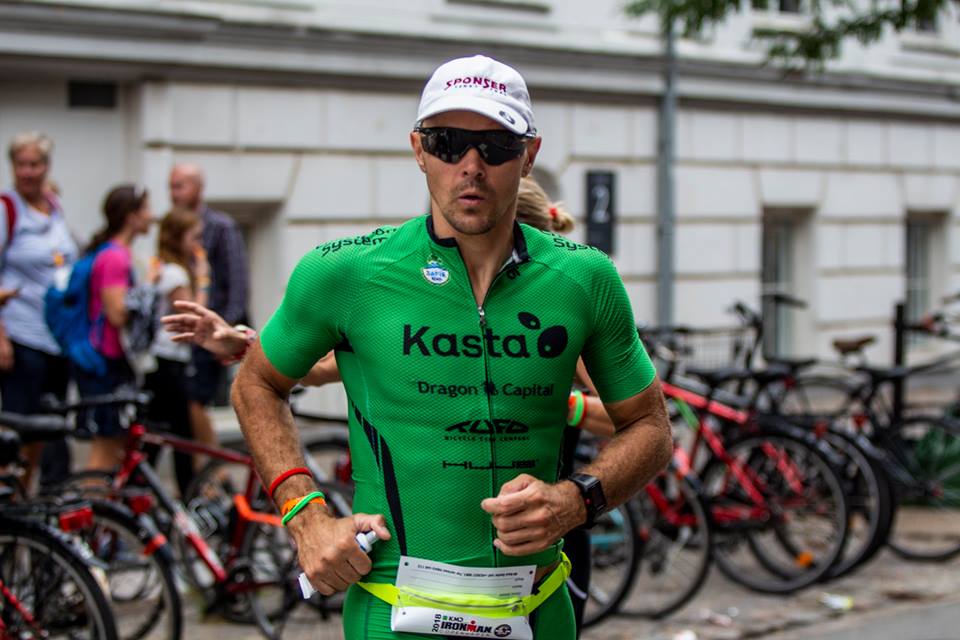
Athlete from Poltava Ivan Ivanov, who for two years in a row got to the TOP-5 stage of the World Cup in the Japanese city of Ishigaki (2012, 2013), is progressing rapidly.
With the beginning of Russia’s military aggression against Ukraine in 2014, the development of sports in our country has stalled somewhat – however, after the stabilization of the situation at the front, the sports results of Ukrainian athletes went up again! At the Olympic Games in Rio de Janeiro in 2016, the flag of our state was again defended by two triathletes – Julia Elistratova and Ivan Ivanov. Eventually, Elistratova will finally establish herself as the best triathlete of our country for the last ten years – Julia takes 4th place at the European Games in Baku, wins a number of domestic and international victories and almost every year tops the ranking of the best triathletes in Europe. As of the end of 2018, the Zhytomyr resident already has seven (!) Medals from the World Cup stages, two of which are gold. In addition, at almost all starts, including top-level tournaments, Elistratova shows the best speed in the running distance and literally bursts into the cohort of the strongest triathletes on the planet.
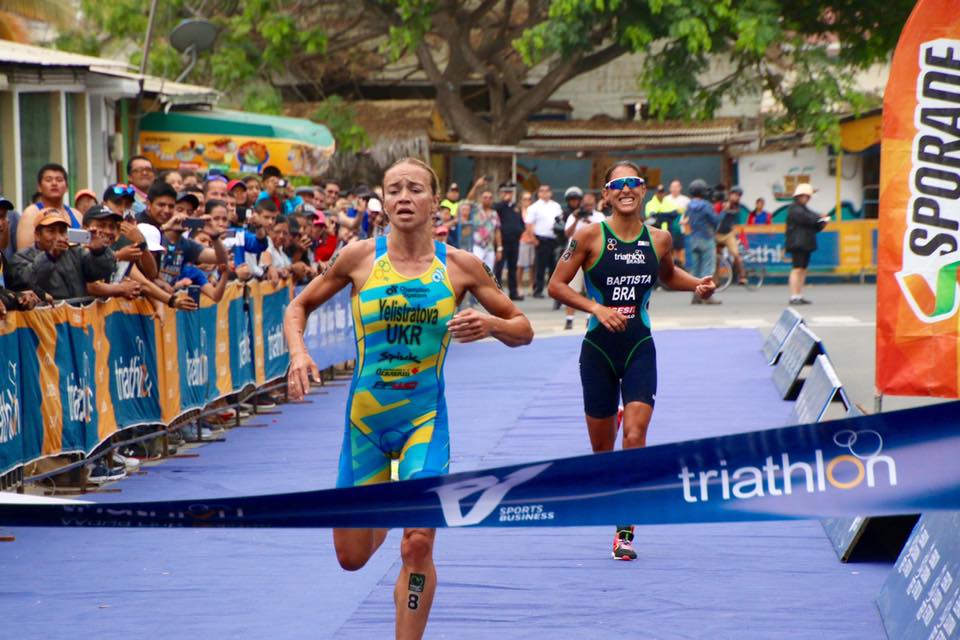
It should be noted that officials, specialists and coaches of the Triathlon Federation of Ukraine carried out fruitful work on the development of our sport in the regions, the promotion of triathlon among veterans of youth, children and other segments of the population. And the rapid dynamics of development of a new sport in Ukraine inspires hope that the time is near when our national pride – TRIATHLETS – will rise to the Olympic pedestal of honor to the accompaniment of the anthem of Ukraine.